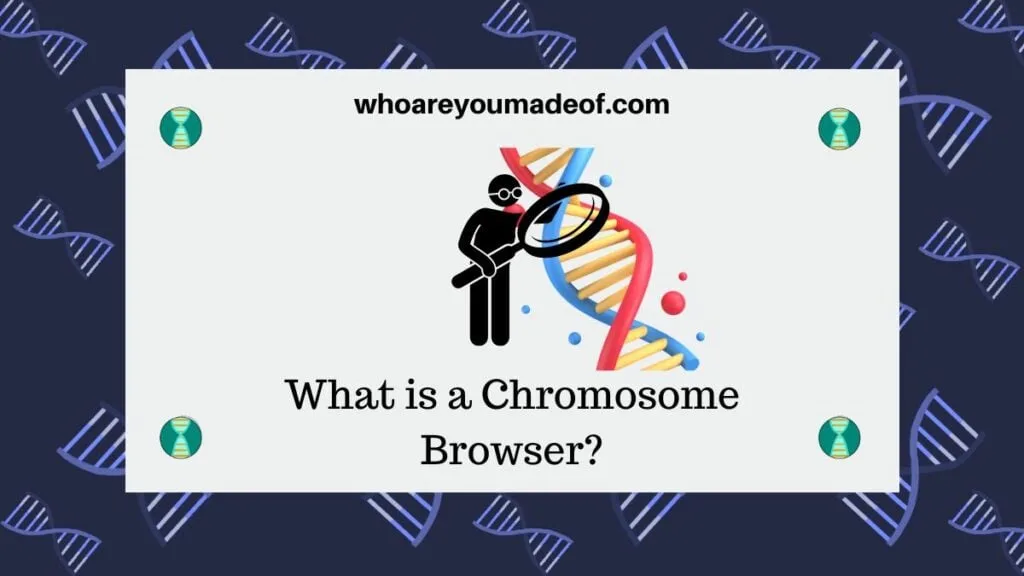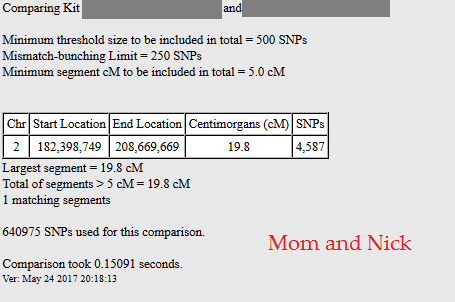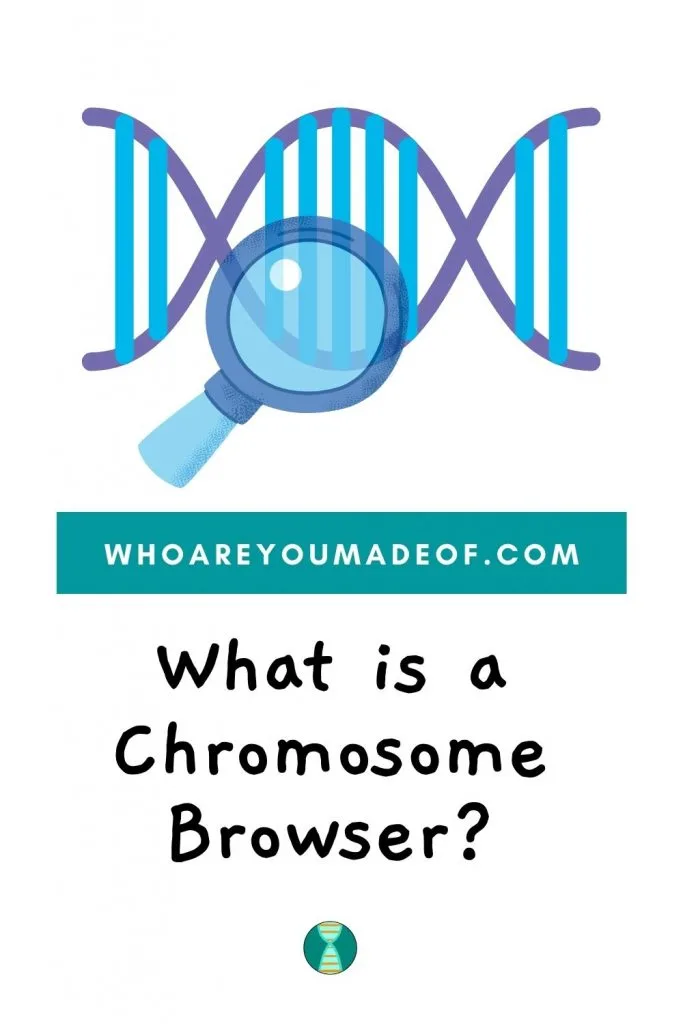Are you ready to learn about chromosome browsers? You’ve arrived at this post, and you are ready to learn all about how a chromosome browser can help you really understand your DNA matches, get the most from your DNA results, and do some really accurate family tree research.
Before we get started learning all about chromosome browsers, I want to assure that even though it seems really scientific and complicated, it’s actually pretty easy.

I feel confident that you’ll be able to learn how to understand how to use a chromosome browser, and once you do, you’ll wonder why it took you so long to start using one.
What is a chromosome browser?
A chromosome browser is a feature available on certain websites or as a part of your DNA results that allows you to compare your DNA with the DNA of another person.
A key aspect of a chromosome browser is the ability to see the location of DNA segments shared on each chromosome.
Forgot what you learned in biology class in high school? Don’t worry – I did, too! Every person has 23 chromosomes. 22 of our chromosomes are numbered (1-22) and the 23rd chromosome is a sex chromosome.
Most of what we talk about here on this website addresses the DNA contained within chromosomes 1-22.
People who are on your DNA match list share DNA segments in common with you, and those DNA segments are located at specific locations on your numbered (1-22) chromosomes.
If you compare your DNA with that of a DNA match using a chromosome browser, you will be able to see the exact location of the DNA segments where you and your DNA match “match”.
Check out the example below. It’s from a comparison that I ran on the chromosome browser on Gedmatch between my sister myself:

The first column shows the chromosome number, the next two show the start and end locations of the DNA segments, and the last column shows how many SNPs were tested. SNP stands for Single nucleotide polymorphisms, but don’t worry about those today.
The image shows that my sister and I have three matching DNA segments on Chromosome 5. Since my sister and I all full sisters (i.e. closely related) we share many DNA segments – more than one segment on each chromosome. Close relatives will share many segments, and distant relatives may only share one or two small segments.
Keep reading to find out how and why the information you can learn from a chromosome browser can be useful to you.
How to get access to a chromosome browser?
Some DNA testing companies offer a chromosome browser as a part of your DNA results. These companies include:
- Family Tree DNA
- My Heritage DNA
- 23 and Me
Unfortunately, Ancestry DNA doesn’t have a chromosome browser (thought they do have a Chromosome Painter, which is admittedly different). I still recommend testing with Ancestry DNA, though, since they have an incredibly large DNA testing database and a lot of other features that go along really well with family history research.
The reason I still recommend this is because your Ancestry DNA results can be downloaded (for free!) and uploaded to a number of different websites that can allow you access to a chromosome browser.
It’s like the best of both worlds!
Ancestry DNA users, along with people who tested with Family Tree DNA, 23 and Me, and My Heritage DNA can upload their DNA to sites where they didn’t do a DNA test:
- Gedmatch, a website that offers free DNA analysis tools (does not offer DNA testing)
- Family Tree DNA
- My Heritage DNA
How can a chromosome browser help me?
Now that you know what a chromosome browser is and where to find one, you are ready to learn what to do with the information that you learn.
Let’s look at an example of one single DNA segment that my mom shares with a distant cousin, who will will call “Nick” for this post. This cousin and and my mom share this identical segment of DNA because they both inherited it from the same ancestor:

If my mom has other DNA matches that match her on Chromosome 2 at similar start and end locations, or overlap most or all of the location on that chromosome, then there is an excellent chance that my mom, Nick, and this other DNA match are all descended from the same common ancestor.
DNA segments are passed down through a process called recombination. DNA segments from each copy of a chromosome recombine when they get passed down, but they stay on the same chromosome. In other words, you won’t have a DNA segment from Chromosome 2 getting passed down and ending up on Chromosome 5.
… Once on Chromosome 2, always on Chromosome 2.
This also means that all of my mom’s DNA matches that match her on the same DNA segment on the same side of her family (see explanation below!) – maternal or paternal – are descended from that same common ancestor. Of course, figuring out who the common ancestor is can be the tricky part, especially if you don’t know much about your family tree.
But, the knowledge about the DNA segment can give you a lot of insight as to which branch of your tree needs to be examined to find your connection to your match(es).
There could be other DNA matches who are indeed descended from the same common ancestor that my mom and Nick share, but some of them might match my mom on different chromosomes.
Important note:
Remember when I said you have 22 chromosomes? This is true, but you actually have two copies of each chromosome. This is because we get one copy of each chromosome from each of our parents.
This is important to keep in mind because when you are comparing DNA segments on a particular location on a chromosome among a group of people, you need to be sure that you match all of those people on the same copy of your chromosome (paternal or maternal).
For example, if you match Bob and Sally on Chromosome 5 on an overlapping DNA segment, you need to be sure that both Bob and Sally are related on the same side of your family (say, your mom’s side).
If they are both on your mom’s side of the family, then there is a good chance that their overlapping segment on Chromosome 5 was inherited from the same common ancestor.
Learn more about this topic:
Conclusion
I hope that you learned enough about chromosome browsers from this post to feel brave enough to give one a try.
If you have any questions about something that you read here, or would like to share your own experience using and learning about chromosome browsers, I would love to hear from you in the discussion below.
Thanks for stopping by!



Rich Ferrar
Sunday 19th of December 2021
Have you written anything on archaic DNA? I submitted my AncestryDNA results to GEDMatch and the results were pretty amazing even without having a clue how to read the chart. I'd attach a screenshot here if I could, but I suspect that's not allowed.
Mercedes
Thursday 6th of January 2022
Hi Rich, Thank you for your question! Yes, I have written about the archaic/ancient DNA samples and matches on Gedmatch. You might be interested in the following articles:
https://whoareyoumadeof.com/blog/how-to-compare-your-dna-with-ancient-dna-samples/ https://whoareyoumadeof.com/blog/what-are-archaic-dna-matches-on-gedmatch/
Thank you again!! Sincerely, Mercedes